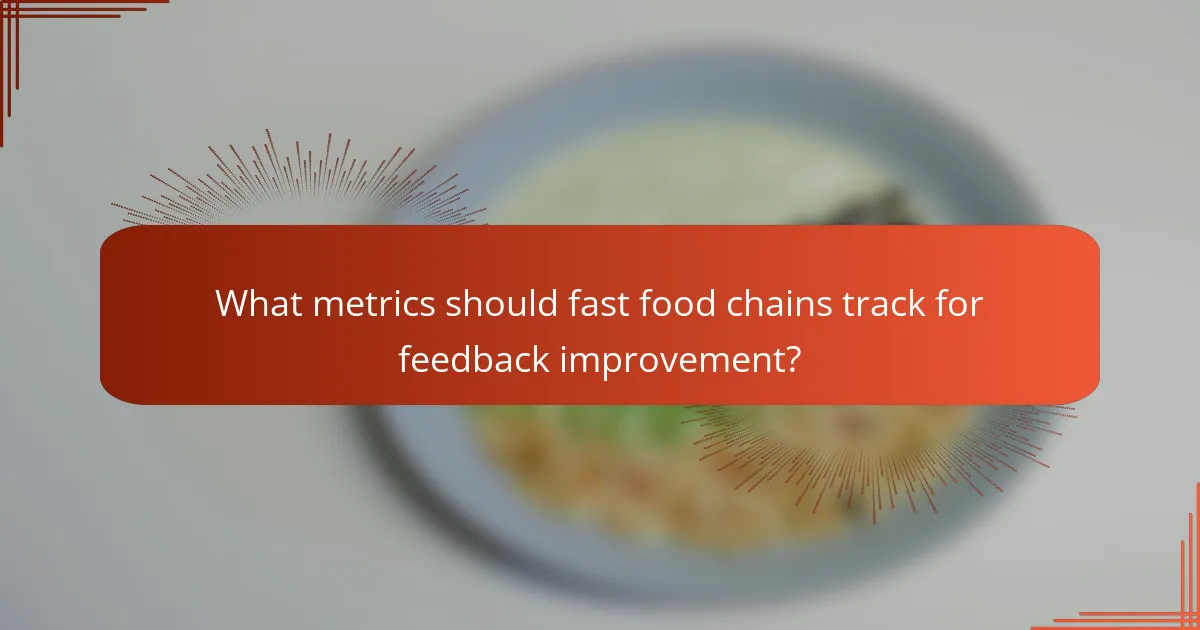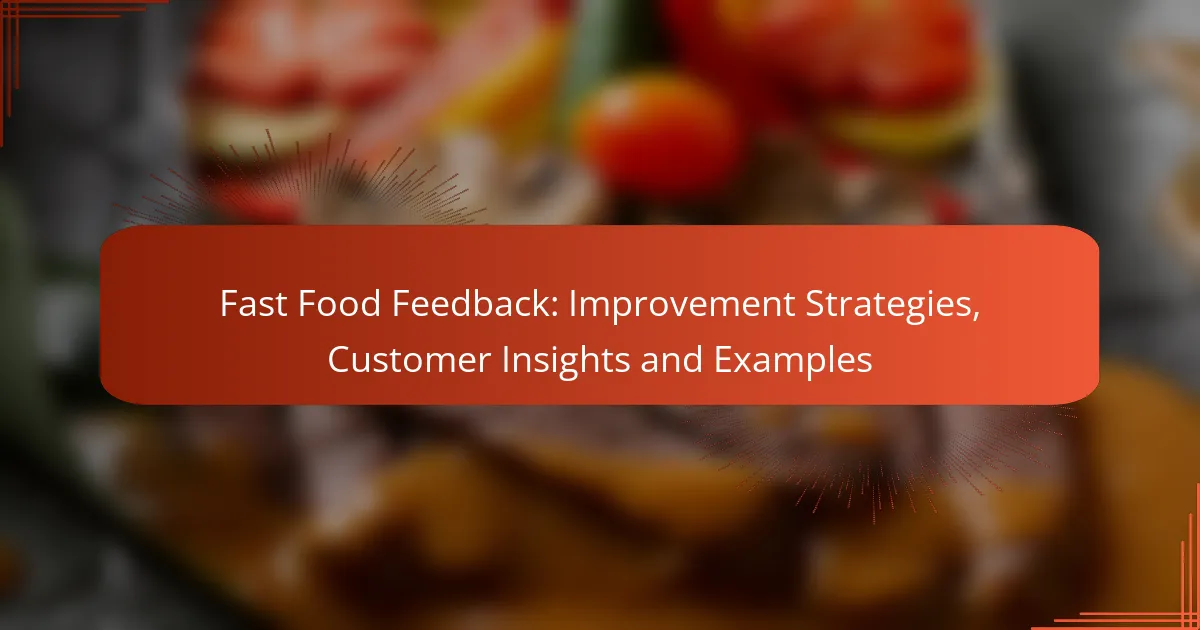In the fast food industry, gathering actionable customer feedback is essential for enhancing service quality and menu offerings. By implementing effective improvement strategies and systematically analyzing insights, businesses can better align their services with customer expectations and identify areas for growth. Timely acknowledgment and personalized communication in response to feedback further build trust and satisfaction among customers.

What are effective improvement strategies for fast food feedback?
Effective improvement strategies for fast food feedback focus on gathering actionable insights from customers to enhance service quality and menu offerings. By employing various methods, businesses can better understand customer preferences and areas needing improvement.
Implementing customer surveys
Customer surveys are a direct way to gather feedback on specific aspects of the fast food experience, such as food quality, service speed, and cleanliness. These surveys can be conducted online or in-store, and should include both quantitative and qualitative questions for comprehensive insights.
To maximize participation, consider offering incentives like discounts or loyalty points. Keep surveys concise, ideally taking no more than a few minutes to complete, to encourage higher response rates.
Utilizing social media listening
Social media listening involves monitoring platforms like Twitter, Facebook, and Instagram for customer comments and reviews about your fast food brand. This strategy helps identify trends, customer sentiment, and potential issues in real-time.
Utilize tools that aggregate mentions and analyze sentiment to gain insights into customer opinions. Responding promptly to feedback on social media can enhance customer relationships and demonstrate that you value their input.
Incorporating mystery shoppers
Mystery shoppers are hired to evaluate the fast food experience from a customer’s perspective, providing unbiased feedback on service, food quality, and overall atmosphere. This method allows businesses to identify strengths and weaknesses in their operations.
When using mystery shoppers, ensure they follow a standardized checklist to maintain consistency in evaluations. Regular assessments can help track improvements over time and ensure staff adherence to service standards.
Leveraging loyalty program insights
Loyalty programs can provide valuable data on customer preferences and purchasing habits. By analyzing this information, fast food chains can tailor promotions and menu offerings to better meet customer needs.
Consider segmenting loyalty program members based on their purchasing behavior to create targeted marketing strategies. This approach can increase customer satisfaction and drive repeat visits.
Conducting focus groups
Focus groups involve gathering a small group of customers to discuss their experiences and opinions about your fast food brand. This qualitative method allows for in-depth conversations and insights that surveys may not capture.
When organizing focus groups, ensure a diverse mix of participants to represent different demographics. Use a skilled moderator to guide discussions and keep them on track, focusing on specific topics like menu items or service experiences.

How can fast food chains enhance customer insights?
Fast food chains can enhance customer insights by systematically gathering and analyzing feedback from various sources. This approach helps identify areas for improvement and align services with customer expectations.
Analyzing customer reviews
Customer reviews provide valuable insights into the strengths and weaknesses of a fast food chain. By regularly analyzing reviews on platforms like Yelp or Google, chains can identify common themes, such as food quality or service issues.
To effectively analyze reviews, consider using sentiment analysis tools that can categorize feedback as positive, negative, or neutral. This can help prioritize areas needing attention and track improvements over time.
Tracking order accuracy metrics
Order accuracy is crucial for customer satisfaction in fast food. Tracking metrics such as the percentage of correct orders can highlight operational inefficiencies and areas for training staff.
Implementing a simple feedback loop where customers can report order issues directly can provide immediate insights. Aim for an accuracy rate above 90% to meet customer expectations consistently.
Monitoring wait times and service speed
Monitoring wait times and service speed is essential for enhancing customer experience. Fast food chains should aim for quick service, ideally under five minutes for drive-thru orders and around ten minutes for in-store orders.
Utilizing timers and customer feedback can help identify peak times and adjust staffing accordingly. Regularly reviewing these metrics can lead to improved efficiency and customer satisfaction.

What are the best practices for responding to customer feedback?
Effective responses to customer feedback involve timely acknowledgment, personalized communication, and public engagement. These practices help build trust and improve customer satisfaction in the fast food industry.
Timely acknowledgment of feedback
Responding quickly to customer feedback is crucial. Acknowledging comments within a few hours shows customers that their opinions matter and encourages further interaction. Aim to address feedback within 24 hours to maintain engagement.
Consider using automated responses for initial acknowledgment, followed by a personalized message. This approach balances efficiency with a personal touch, ensuring customers feel heard.
Personalized responses to complaints
When addressing complaints, tailor your responses to the specific issue raised. Use the customer’s name and reference their experience to create a connection. This personalization can significantly enhance customer loyalty.
For example, if a customer complains about cold food, respond with empathy and offer a solution, such as a refund or a replacement meal. This shows that you value their experience and are committed to improvement.
Publicly addressing issues on social media
Publicly responding to feedback on social media can demonstrate transparency and accountability. Addressing issues in a public forum shows other customers that you take complaints seriously and are willing to resolve them.
When responding publicly, keep your tone professional and constructive. Acknowledge the issue, apologize if necessary, and outline steps being taken to prevent recurrence. This approach can turn a negative experience into a positive impression for potential customers.

Which fast food brands excel in customer feedback management?
Chick-fil-A, McDonald’s, and Starbucks are notable for their effective customer feedback management strategies. These brands leverage customer insights to enhance service quality, improve menu offerings, and foster loyalty.
Chick-fil-A’s customer service training
Chick-fil-A emphasizes rigorous customer service training for its employees, focusing on creating a positive dining experience. Staff are trained to engage with customers warmly, listen actively, and resolve issues promptly, which fosters a culture of feedback and responsiveness.
This commitment to service excellence is reflected in customer surveys, where Chick-fil-A often ranks highly for satisfaction. Regular training refreshers ensure that employees remain aligned with the brand’s service standards.
McDonald’s feedback app integration
McDonald’s has integrated customer feedback mechanisms directly into its mobile app, allowing users to rate their experience and provide suggestions easily. This real-time feedback collection helps the brand identify areas for improvement and adapt quickly to customer preferences.
Additionally, McDonald’s often incentivizes feedback through promotions or discounts, encouraging more customers to participate. This strategy not only enhances customer engagement but also provides valuable insights into menu items and service efficiency.
Starbucks’ personalized customer interactions
Starbucks excels in creating personalized customer interactions by utilizing data from its loyalty program. By analyzing purchase history and preferences, the brand tailors marketing messages and offers, making customers feel valued and understood.
Starbucks also encourages feedback through its app and in-store surveys, allowing customers to share their experiences. This approach not only improves customer satisfaction but also helps Starbucks refine its product offerings and service strategies based on direct customer input.

What metrics should fast food chains track for feedback improvement?
Fast food chains should focus on key metrics like customer satisfaction scores and net promoter scores (NPS) to effectively gauge and improve customer feedback. These metrics provide insights into customer experiences and loyalty, guiding operational enhancements.
Customer satisfaction scores
Customer satisfaction scores measure how well a fast food chain meets customer expectations. Typically gathered through surveys, these scores can range from 1 to 10, with higher scores indicating greater satisfaction. Monitoring these scores helps identify strengths and weaknesses in service, food quality, and overall experience.
To effectively use customer satisfaction scores, fast food chains should regularly survey customers after their visits. This can be done through digital platforms, receipts, or in-store kiosks. Aim for a target score above 80% to indicate a strong customer experience.
Net promoter score (NPS)
The net promoter score (NPS) assesses customer loyalty by asking how likely customers are to recommend the chain to others, typically on a scale from 0 to 10. Customers are categorized as promoters, passives, or detractors based on their responses, with a higher NPS indicating a more loyal customer base.
Fast food chains should calculate their NPS regularly to track changes over time. A good NPS for the industry often falls between 30 and 50. To improve NPS, focus on addressing feedback from detractors and enhancing the overall customer experience.



